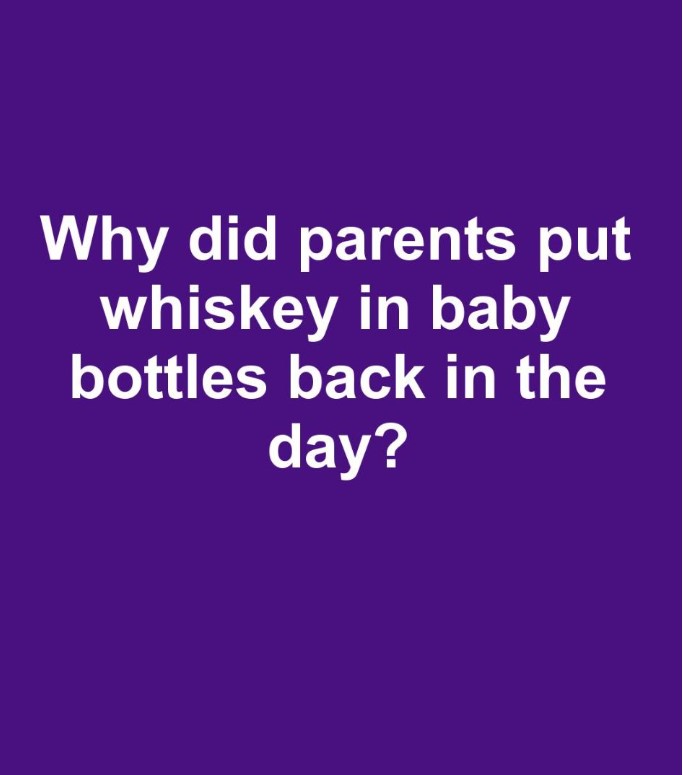Parenting is a journey filled with choices, many of which are shaped by the cultural, social, and medical landscapes of the time. Throughout history, various practices have emerged, some of which may raise eyebrows today. One particularly striking example is the historical use of whiskey in baby bottles—a practice that, while shocking now, was once considered a common remedy for soothing infants. This article delves into the historical context of this practice, exploring the cultural and medical beliefs that influenced parenting decisions in earlier eras.
The Cultural Context of Whiskey Use in Childcare
In numerous societies, alcohol has long been viewed as a medicinal substance. During the 19th and early 20th centuries, whiskey was not merely a recreational drink; it was often seen as a cure-all for various ailments. This cultural perception laid the groundwork for the use of whiskey in childcare, where it was believed to alleviate health issues ranging from coughs to digestive discomfort. In communities where access to modern medicine was limited, whiskey became one of the few remedies parents could turn to when seeking relief for their children’s ailments.
Understanding the Perceived Benefits of Whiskey for Babies
Parents who resorted to using whiskey in their infants’ bottles held various beliefs about its benefits. Primarily, they thought it had a calming effect that could soothe fussy or colicky babies. The alcohol content was believed to induce sleep, offering much-needed rest for both the child and the exhausted parents. Additionally, whiskey was sometimes employed as a remedy for teething pain, as it was thought to numb the gums and lessen discomfort. These perceived advantages made whiskey an appealing choice for parents desperate for quick fixes to common childhood challenges.
Medical Advice and Common Beliefs of the Time
The era when whiskey was commonly used in baby bottles was characterized by a lack of standardized medical advice. Many doctors of the time endorsed the use of whiskey and other home remedies for treating various ailments. The absence of rigorous scientific research and a limited understanding of child development contributed to the acceptance of such practices. Medical practitioners often relied on anecdotal evidence and traditional knowledge, which reinforced the belief in whiskey’s effectiveness as a remedy for infants.
The Role of Whiskey in Soothing and Teething Remedies
Teething is a notoriously difficult phase for both infants and parents, marked by irritability and discomfort. Without access to modern teething gels and pain relievers, parents frequently turned to whiskey as a natural anesthetic. By applying a small amount of whiskey to the baby’s gums or adding it to a bottle, they hoped to alleviate pain and help their child sleep. This practice, passed down through generations, became a common household remedy, despite the potential risks associated with alcohol consumption in infants.
Societal Norms and the Acceptance of Alcohol in Childcare
The societal norms of the time also played a significant role in the acceptance of whiskey in childcare. In many communities, alcohol was woven into the fabric of social life and was not regarded with the same caution as it is today. The absence of stringent regulations regarding alcohol consumption, coupled with its widespread availability, made whiskey a convenient option for parents. Moreover, the social acceptance of alcohol use among adults likely contributed to its use in children, as the potential dangers were not fully understood or acknowledged.
The Shift in Medical Understanding and Parenting Practices
As medical science progressed, so too did the understanding of alcohol’s effects on the human body, particularly in children. By the mid-20th century, research began to illuminate the potential harms of alcohol consumption in infants, leading to a significant shift in medical advice and parenting practices. Public health campaigns and the development of safer, more effective remedies for common childhood ailments contributed to the decline of whiskey use in baby bottles. This transition was part of a broader movement towards evidence-based medicine and a heightened awareness of child health and safety.
Modern Perspectives on Historical Childcare Methods
Today, the notion of placing whiskey in a baby bottle is met with disbelief and concern. Modern parents have access to a wealth of information and resources that promote safe and healthy childcare practices. The historical use of whiskey serves as a poignant reminder of how far our understanding of child health has come. It highlights the importance of questioning traditional practices and being open to new information. Ongoing education and research are essential to ensure that parenting methods continue to evolve in ways that prioritize the well-being of children.
Conclusion:
Lessons Learned from Past Practices
Reflecting on the historical use of whiskey in baby bottles offers valuable insights for contemporary parenting. It underscores the importance of critically evaluating traditional practices and relying on scientific evidence to guide childcare decisions. As society progresses, it is crucial to remain receptive to new information and adapt practices accordingly. By learning from the past, parents and caregivers can ensure that they provide the best possible care for future generations, prioritizing safety, health, and well-being above all else.










